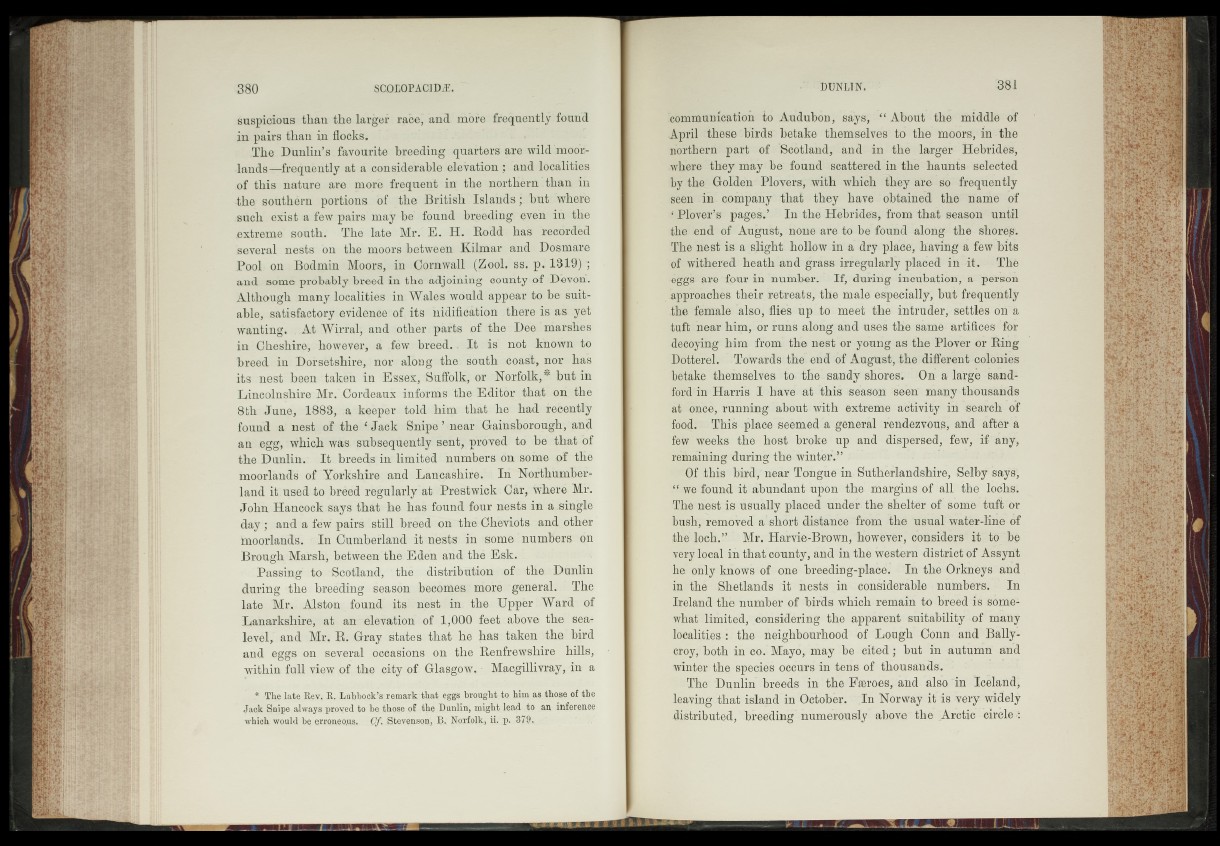
suspicious than the larger race:, and< more frequently found
in pairs than iu flocks,
.The Dunlin’s favourite breeding quarters are wild mobri
lands-t-freqnently at a .considerable elevationj and localities
of this nature are more frequent in the northern .than.in
the southérn portions of the British Islands frfbut where
csiich exist a few pairs’may be* found breeding;'even in the
extreme’ south. The late Mr. E. H. Rodd has recorded
several nests bn the moors between Kalmar and Dosmare
Pool, on . Bodmin Moors, in tQornwall (Zool, ss< p. 1819^
and some probably breed in the adjoining county of -Devon.
Although ;many localities inr Wales would appear be suitable,
satisfactory evidenée'of. its | hidihcation there is as. .yet
wanting; . At Wirfal; and mother U parts pfidiMêvDéAinaarshes
in - Cheshire, however, a few brSId. »* I t is not known ifco
breed in Dorsetshire, j nor alongc: the/ south/; coast, nor has
its ;nest: be©n taken in USsex, BufBolk;,* or rNoxMi;^ b u t^ .
Lincolnshire Mr.’ Cordeaux "informs the Editor that on the
8th June, 1883, -a- keeper .-told .him thatch^ had recently
found a nest of the Jack -Snipe ’ -near Oaigisborough, and
an egg, which was subsequently- sent, proved td he that "of
the Dunlin. It- breedsin limited numberssdnosome pf tKe
moorlands ;bf Yorkshire and'Lancashire,' In NerthumBef*
land’ ittreetkto brééd regularlyAt"'ferestwick. Car> where Mr,
John Hancock says that ha has found four nests in a,single
day ; and ?a féM pairs still breed/bh'the. Cheviots and other
moqrlands. - In Cumberland it nests1 in ■ som'edimmbers sqn
Brough Marsh, between the Eden and thé Esk.
Passing to 'Scotland, the distribution of ’ th e Dunlin
during th e breeding seasons becoune&r m o^k generate ;■ The
late Mr. Alston | found its *npst.‘in the Upper 1 Ward1 of
Lanarkshire, at am-elevation of 1,0B0 feet:above the sea*
level/ and Mr, R. Cray states, thafsphe has. takenuthe..bird
and eggs omsesÉSal occasions on the Renfrew dmv, lull-i.
within full view of the city ,pf- Clasgo^U-/ Macgillivray,-in a
* Tl\e |ate B$;j^ B. remark'ttat eggs brquglit -tq him as those of: $he
Jaolc gnipe-always proved-to be those of-tBq.-hunljn, might-leadr^fco AA- wlprgijce
which would be qrrqn,eo,Tjs, . (Jft .SteTfnsqp, Bv Norfolk»
^communication to Audubon, says, About the middle of
April these Thirds: betake themselves to the moors, in the
northern part of "Scotland; and-.in - the larger Hebrides-,
.where they may be found scattered in the haunts- selected
bytthè/ CoIdén. Plovers,'.With-which they are so frequently
seen-in. company: that they have obtained the'name of
^Plover’s pages.’ In the Hebrides, from that season until
the end *•©£'August, none are-to be found -along- the shores
The nest'is a slight hollow-in a dry place, -having' a few bits
of withered heath and grass irregularly placed in -It. - Thé
eggs are four in "number. If, during incubation, a person
Approaches their retreats, the male£'especially; but frequently
•the female "also, flie's uplf© meet the intruder," settles dir a
tuft hear him, or runs along and uses the same- artifices for
.decoying him-from" the nest or-yohng as the Plover or Ring
Dotterel. ".Towards* the’end:of August, the different-colonies
betake themselves lo*‘t£e". sandy shores; Oh a large«land-
fead'In Harris I have at--this <season 'seen' many thonsanFd'S
at once, running about With extreme activity«in ^search <&
food. u-This -place seemedTa general :rendexvorfs, and: after a
few Weeks'the-host broke up and dispersed,1 few, if any,
remaining during the Wintert’ M
Qf this bird, near Tongue in. Sutherlandshire, Selby sayS>
U;,.we foundsiliabnhdant hpom the margins; of ^11 :'f?h'è' loehst
Mh&'nest' is usually placed -under- the shelter of some tuft or
bush,’removed* a-short- distance from the ‘usual watèr-line of
the loch.” Mr. Ha*rvïê:Browfl,'however,' consider^ R tfo'be
very toöalrihtfeat county,Andunthè western districtof Assyrft
he" only knows of one breeding-place.* the Orkneys and
infethe '^betlandS liffahesfl- in considerable numbers. In
Ireland the number®!-birds' which remain to-Kreèd-is sóm#-
what llimited, considering "the apparent suitability> of manf
localities a. the neighbourhood of Lo,ugh Conn- and'Dally;
JWoy^both in eO&Mayó, may *be . cited • but In'autumn and
winter'the species occur-s in tens of thousands.
; 'The Dunlin breeds in - the Faeroes,.and also “in Iceland,
leavingvthat island"in October.'^n Norway it is véryWldely
distributed, breeding -numerously above' the .Arctic circle 3